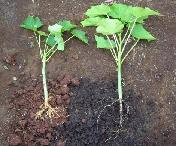What is the Agrichar process?
Agricultural feedstocks such as animal manure, rice hulls, peanut shells, corn stover or forest waste are pyrolized at low temperatures to produce a char product (Agrichar or biochar) and separate bio-energy streams, in the form of oils and/or gases. The biochar captures about 50% of the carbon in the feedstock, and can be used as a soil amendment to improve soil fertility, stability, and productivity, and to store carbon in the soils, as a means of mitigating global warming. The use of Agrichar in soils mimics the Terra Preta (dark earth) soils of the Amazon Basin, which have sequestered high quantities of carbon for thousands of years, and have dramatically improved soil fertility and sustainability without chemical inputs. The bio-energy produced, which accounts for the other 50% of feedstock carbon can be used to fuel a variety of energy needs.
 Seedlings illustrating the difference between plants grown in biocharamended soil (darker soil on the right). Photo courtesy of Robert Flanagan.
Seedlings illustrating the difference between plants grown in biocharamended soil (darker soil on the right). Photo courtesy of Robert Flanagan.Dr Peter Read will be speaking on Agrichar at the Kaiwaka Sports Complex on Wednesday 24 October Contact Faye on 4312145 for your ticket.